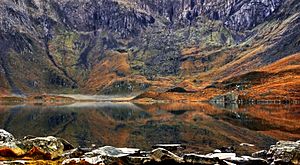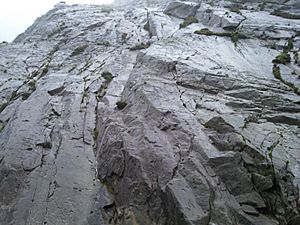Cwm Idwal facts for kids
Cwm Idwal is an amazing valley shaped like a half-circle. You can find it in the Glyderau mountains in Snowdonia, a beautiful national park in North Wales. It's a popular spot for people who love to hike and climb rocks. Scientists who study rocks (geologists) and plants (naturalists) also find it very interesting. This is because of its high altitude, its north-facing slopes, and its rocky landscape. In 2005, a poll by Radio Times named Cwm Idwal the 7th greatest natural wonder in Britain.
Contents
How Cwm Idwal Was Formed
Cwm Idwal is a fantastic example of how glaciers can shape the land. It is surrounded by tall cliffs, piles of loose rocks (scree), and rounded hills made of rock and dirt (moraines). A beautiful lake called Llyn Idwal sits on the valley floor.
Rocks and Ancient Seas
The rocks in Cwm Idwal are a mix of volcanic rock and sedimentary rock. These rocks were first laid down a very long time ago in a shallow sea during the Ordovician period. Later, the Earth's movements folded these layers of rock. This created a special trough-shaped fold called the Idwal Syncline. You can still see this fold today because of the way the rock layers are stacked.
Shaped by Ice
After the rocks were folded, huge glaciers moved through the area. These glaciers slowly carved out the classic half-circle valley we see today. They smoothed some rocks and left behind others, creating the unique landscape of Cwm Idwal.
Amazing Plants of Cwm Idwal
Cwm Idwal is a special place for plants. Because it's high up and faces north, it's one of the most southerly places in Britain where you can find Arctic plants.
Arctic and Alpine Flowers
Some of these rare plants include moss campion and certain types of alpine saxifrages. You might spot the tufted saxifrage (Saxifraga cespitosa) or Micranthes nivalis here.
The Snowdon Lily
Cwm Idwal is also home to the Snowdon lily. This special plant can only be found in the UK on Snowdon mountain and its surrounding areas.
Famous Botanists and Rare Finds
A well-known botanist named Evan Roberts from Capel Curig spent a lot of time studying the plants here. He helped document many of the unique species. Another rare plant, the Snowdonia hawkweed (Hieracium snowdoniense), is only known to grow in Cwm Idwal.
Climbing and Walking Adventures
Cwm Idwal is a very popular place for outdoor adventures. Many people come here for rock climbing, hill walking, and scrambling.
Rock Climbing Spots
The cliffs around the head of Cwm Idwal are great for rock climbing. A famous spot is Rhiwiau Caws, also known as the Idwal Slabs. These slabs are on the eastern side of the valley and are very popular with new climbers learning the ropes. The first climbers to tackle them were Rose and Moss in 1897.
Winter Ice Climbing
In the winter, when it's cold enough, Twll Du offers excellent ice climbing. This is when climbers use special tools to climb frozen waterfalls and ice formations.
Hiking and Scrambling
The Cwm is also a favorite for hill walking and scrambling. Scrambling is like a mix of hiking and easy climbing, often using your hands. It's close to famous mountains like Tryfan, Glyder Fach, and Glyder Fawr, which have many rocky ridges to explore.
Everest Explorers' Camp
In the 1950s and 1960s, Cwm Idwal was a meeting place for the first people to climb Mount Everest and Kangchenjunga. Many of these explorers were also keen geologists and botanists. They would gather at a place called Pen-y-Gwryd nearby.




